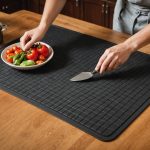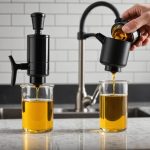Choosing the Right Manual Coffee Grinder
Selecting the perfect manual coffee grinder can significantly enhance your coffee-brewing experience. The variety of grinders available, each with distinct features, ensures there’s a suitable choice for everyone. Manual to electric grinders come with various types such as burr and blade. Burr grinders, known for their precision, yield a uniform grind offering better flavor extraction. However, they can be more expensive and require maintenance. In contrast, blade grinders are budget-friendly and easy to use, albeit less consistent.
When considering a high-quality manual grinder, pay attention to key features. The grind size settings should be adjustable, allowing flexibility across different brewing methods. Material quality is crucial; look for durable components, typically stainless steel or ceramic burrs, which enhance longevity and performance.
Have you seen this : Transform Your Culinary Space: Maximize Efficiency and Style with Innovative Rotating Spice Racks
Understanding the importance of grind size and consistency is fundamental to achieving the desired coffee flavor. A consistent grind reduces over-extraction, where bitter notes arise, or under-extraction, leading to sour tastes. Different brewing methods demand specific grind sizes – for instance, espresso requires a finer grind, while a French press benefits from coarser particles. Thus, selecting a grinder capable of delivering reliable grind consistency is essential for optimising flavor. Remember, investing in the right manual grinder is a step forward in your coffee journey.
Tips for Achieving Optimal Grind Consistency
Ensuring grind consistency is crucial for a well-balanced coffee flavour, as it affects extraction rates. Adjusting grinder settings is key; start by coarsely grinding, then refine until the desired size is achieved. Precision is essential, so take note of preset notches or marks on the grinder. This minimizes guesswork and leads to more uniform results.
Have you seen this : The Definitive Potato Masher Selection: Protect Your Non-Stick Cookware from Damage!
Hand-grinding techniques also play a role in achieving consistency. Ensure a steady and even rotation when turning the handle. Quick, jerky movements can lead to uneven grinds. Instead, maintain a controlled pace to reduce variability in particle size. Proper technique ensures that each grind remains consistent, leading to improved flavour extraction.
The type and freshness of your beans significantly influence grind consistency. Fresh beans retain oils that affect how they break apart during grinding. Ideally, use beans roasted within the last two weeks to achieve optimal results. Older beans are often dryer, resulting in inconsistent particles that can alter the intended brew flavour.
For improvement, remember these essential practices:
- Adjust settings incrementally for precision.
- Grind with consistency and control.
- Utilize fresh beans to maintain uniformity.
These strategies enhance grind consistency, improving coffee flavour nuances.
Adjustments for Different Brewing Methods
Tailoring your grind size according to specific brewing methods is essential for a balanced coffee flavour. Each method demands unique brewing method adjustments, ensuring optimal extraction.
Espresso Brewing
Espresso brewing requires a fine grind, akin to powder. The compact particles ensure a short brewing time, as finer grounds allow water to extract flavours swiftly. It’s crucial to refine grind settings meticulously. Aim for a consistency where the grinds clump slightly when pressed. Adjusting the grind to this precision helps achieve that rich and velvety espresso shot every enthusiast craves.
Pour Over
For pour over techniques, a medium grind is ideal. This size enables water to pass at a measured pace, allowing even extraction. A balance between water flow and grind size ensures clear, complex flavours with every cup. Experiment with slight grind size recommendations refinements to perfect your personal brew, paying attention to brewing time adjustments.
French Press
The French press demands a coarser grind, akin to sea salt. Coarse particles prevent over-extraction during the longer brewing time typical for this method. Adjust to ensure even particle size, avoiding fines that muddy the brew. Consider grind adjustment as crucial for optimal extraction, ensuring a robust and aromatic cup every time.
Maintenance and Care for Manual Grinders
Ensuring manual grinders are well-maintained is crucial for their long-term performance. Regular cleaning not only prolongs the life of the grinder but also contributes to consistent coffee flavours. Cleaning tips involve disassembling the grinder—detach handles, hop, and burrs as needed. This routine ensures no residual coffee oils or particles interfere with flavor balance.
It is vital to maintain both blades and bearings. For grinders with stainless or ceramic burrs, these components require periodic checks for any signs of wear. Regular lubrication of bearings can prevent rust and ensure a smooth grinding process. When surfaces are not sharp or movement becomes sluggish, it may indicate the need for more thorough servicing.
Recognise signs that indicate servicing. A noticeable drop in grind consistency or increased effort during manual operation suggests components may need cleaning or replacing. Address such issues promptly to continue enjoying high-quality coffee.
Neglect can lead to reduced grinder longevity, requiring costly repairs or replacements. Adhering to proper maintenance practices keeps the grinder in peak condition, ensuring every cup of coffee remains as delightful as anticipated. Prioritising these small efforts guarantees a more rewarding brewing experience.
Comparison of Top Manual Grinders on the Market
When seeking a top manual grinder, understanding the market can enhance your coffee experience. Several leading manual grinders offer unique features catering to diverse preferences, making comparison essential.
Overview of Leading Grinders
This comparison includes acclaimed models like the Hario Skerton, Porlex Mini, and Lido 3. Each grinder stands out for particular attributes; the Hario Skerton is known for its large capacity, while the Porlex Mini is celebrated for portability. The Lido 3 impresses with its precision and fine-tuning capabilities.
Comparative Analysis
Performance is a crucial factor when choosing among top manual grinders. The Porlex Mini, with its ceramic burrs, ensures consistent grind size suited for travel, albeit at a higher price point. The Hario Skerton, more affordable, offers versatility with adjustable settings but requires additional stabilisation during use. Lido 3, though expensive, boasts reinforced steel burrs, presenting unparalleled grind consistency and ease of adjustment.
User Reviews and Testimonials
Customer testimonials commend the Porlex Mini for its compact design attractive to on-the-go coffee lovers. The Hario Skerton receives praise for its user-friendly nature and affordable price, while the Lido 3 gains acclaim for exceptional grind precision and durability. Balancing performance with budget is key when making the final selection for your manual coffee grinder needs.




